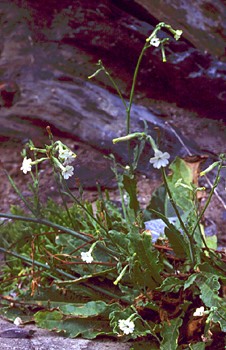
Synonymy
Nicotiana maritima H. Wheeler, Univ. Calif. Publ. Bot. 18(4): 56 (1935)
T: Hallet's Cove, S.A., Sept. 1932, J.B. Cleland s.n.; holo: UC n.v.; iso: AD 97615147.
Description
Herb to 1 m; leaves and stems variably pubescent with non-glandular hairs, usually white- or grey-woolly at base of stems.
Leaves mostly radical, ovate or elliptic, petiolate, the upper cauline ones narrowly elliptic or lanceolate, usually sessile; lamina up to 22 cm long; petiole to 9 cm long, usually broadly winged and often slightly stem-clasping.
Inflorescence panicle-like, usually few-branched, pubescent with glandular hairs. Calyx 6–16 mm long; intersepalar membranes often conspicuous. Corolla-tube 13–30 mm long, 2–5 mm wide at top of calyx, distinctly narrowed at base; limb 8–24 mm diam.; lobes usually notched. Upper 4 anthers at about the same level, their filaments to 4 mm long; filament of the 5th stamen 6–12 mm long, inserted in lower half of corolla-tube.
Capsule ellipsoid to ovoid-ellipsoid, 4–12 mm long. Seeds mostly reniform or acutely angled; testa irregularly honeycombed or wrinkled. n=16.
Distribution and ecology
Mainly restricted to coastal regions of Eyre Peninsula, Yorke Peninsula, Southern Lofty and South Eastern regions of S.A. and adjacent offshore islands, but known from early collections in western Vic.
Grows mostly in sandy, gravelly or rocky soil, often on the coast or along creek banks near the coast.
Notes
A variable species very similar to N. suaveolens Lehm. and N. velutina H. Wheeler; distinguished from N. suaveolens by the pubescent stems and leaves and from N. velutina by the reniform or acutely angled seeds.
Commonly known as Coast tobacco.
According to Pandey (1969) this species has flowers which are self-compatible.
Reference: Pandey, K. K. (1969) Elements of the S-gene complex V. Interspecific cross-compatibility relationships and theory of the evolution of the S complex. Genetica 40, 447-474.
A valuable summary of the cultural use of Nicotiana species in Australia is provided in D.E.Symon (2005). Native tobaccos (Solanaceae: Nicotiana spp.) in Australia and their use by Aboriginal peoples. The Beagle 21: 1-10.
Selected specimens
S.A.: S of Tumby Bay, C.R. Alcock 1095 (AD, CANB); Second Valley, D.E. Symon 10563 (AD); Woods Well—Culburra road, L.D. Williams 578 (AD).
Web links
A fact sheet for this species can be downloaded from the SA eFlora site.







